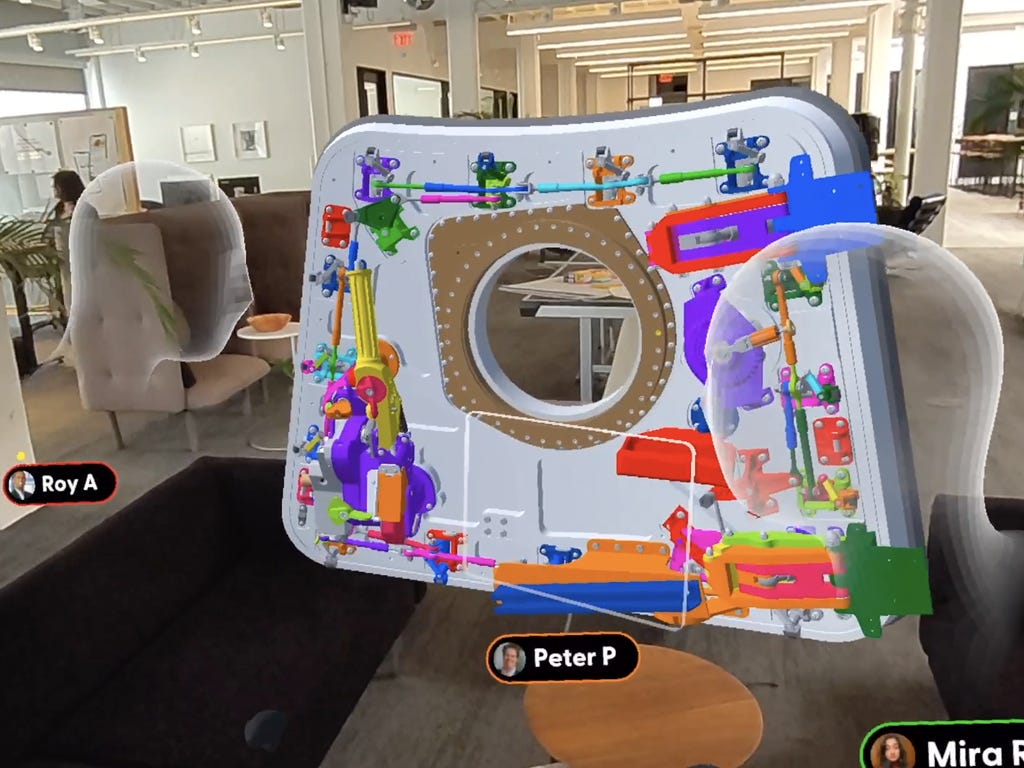
Courtesy of Campfire
Reviewing 3D models on a 2D platform like PowerPoint can make product development difficult, but AR/VR might change that.
At Collins Aerospace, a leading manufacturer of aerospace equipment, engineers and designers can now use AR/VR headsets to view CAD files in real time, letting them view and change designs far more quickly than before. Thomas Murphy, a manufacturing programs chief engineer at Collins Aerospace, told Business Insider the change is like Sears switching from a catalog to e-commerce.
To make this possible, the company has tapped a relatively young AR/VR collaboration tool called Campfire.
Jay Wright, the CEO of Campfire, sees the platform’s use at companies like Collins Aerospace as just the beginning of AR/VR collaboration. Unlike many of Campfire’s competitors, which often target narrow use cases, Wright hopes to make AR/VR collaboration as popular and accessible as videoconferencing platforms like Zoom.
“People can just start. They can download something for free, and then they can upgrade to a paid plan when they feel they’ve exhausted the features of what’s free,” Wright said. “Just like a Zoom, a Teams, a Slack, a Miro, a Figma. That’s the exact same thing with Campfire.”

Courtesy of Campfire
Taking AR/VR collaboration mainstream
The adoption of AR/VR collaboration has been slow in part because most tools are difficult to download and use. Many lack a free trial, or if one is offered, it may only be available for a limited time. Hardware requirements, like a headset or a powerful computer, and device compatibility are additional obstacles. This can raise barriers for companies and individuals looking to explore the tech before making a full investment.
Like many AR/VR collaboration apps, Campfire is designed for 3D, real-time collaboration in an AR/VR environment. Users can load 3D files and view them at an accurate scale, zoom in and out to see components in more detail, and make alterations on the fly.
But unlike most competitors, Campfire also provides a comprehensive free tier. Under this plan, users can view up to five projects with up to five collaborators and receive 5GB of total file storage. The free tier has no time limits. Campfire also offers broad device compatibility, including Windows, Mac, Varjo headsets, and more.
“It’s a model similar to other software-as-a-service, where people can download something for free,” Wright said. “People can use models up to a certain size, in certain formats, and it’s really good. They can see what the collaboration experience looks like, they can put their own data in.”
Even with the recent release of more affordable and accessible headsets, like Meta’s Quest 3, flexibility is key to the company’s strategy. Wright said roughly 80% of Campfire’s users log in through a computer, tablet, or phone. If collaborators on a project lack a headset, they can still use a laptop to view the perspective of a team member who’s wearing the device.

Courtesy of Thomas Murphy
From ideation to the air
Collins Aerospace, a subsidiary of RTX, builds components for commercial and defense aviation, from navigation equipment and landing gear to passenger seats. The company began using Campfire in 2023.
Murphy told BI he sees an opportunity for the tech to reinvent the company’s complicated review process. Collaborators typically view the 3D models, take detailed notes, create action items, make changes, reconvene to discuss the updates, and repeat until they finalize the product.
“We have design reviews, and we’re pasting 3D models into two-dimensional PowerPoint slides and going through those cross-sectional views on a Zoom call,” Murphy said.
Campfire, by contrast, allows direct and real-time collaboration. Murphy said users can view 3D CAD files that offer a much clearer representation of what a final product will look like. Collaborators can also alter the file in real time, making it possible to share iterations on the spot and experiment with new ideas.
The aerospace industry’s demanding timelines make speedy collaboration particularly valuable. Murphy said that Collins Aerospace needs to move in step with major customers. “From the Boeing and Airbus perspective, they’re looking for us to have the agility,” he said.
While the tech has been used successfully at Collins Aerospace and companies like DataFusion and Whirlpool, Campfire could face potential adoption hurdles as tech giants remain undecided about AR/VR technology. Microsoft, for example, has largely retreated from Windows Mixed Reality and HoloLens, the holographic headset it once pitched to engineers, and Meta’s Reality Labs reported a $4.2 billion loss in the first quarter of 2025.
Even so, Wright told BI that the time is right for AR/VR collaboration to go mainstream.
“Everything is not obvious until the moment that it’s very obvious,” he said. “The promise has been there for a long time, and it’s just a matter of getting to that tipping point where you’ve got price, performance, and a user experience that makes it simple.”
The post This tech startup wants to shake up AR — and the aerospace industry is paying attention appeared first on Business Insider.




